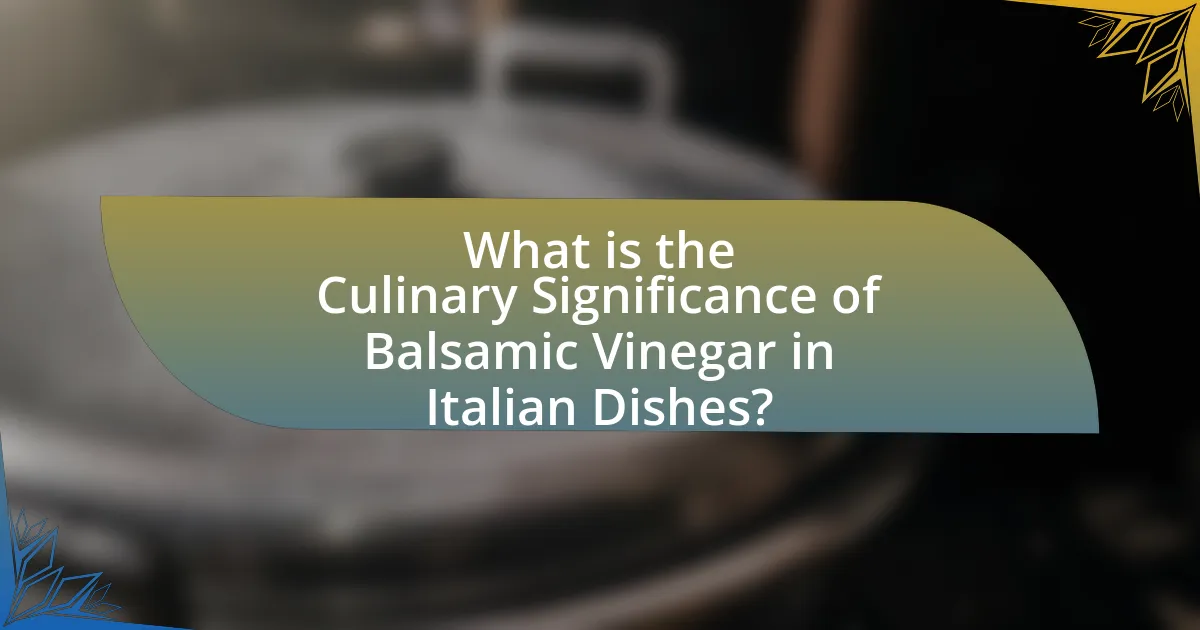Balsamic vinegar is a crucial component of Italian cuisine, renowned for its unique flavor profile and versatility in enhancing a wide range of dishes. This article explores the traditional production methods of balsamic vinegar, particularly its aging process, which contributes to its complex taste and aroma. It highlights the various types of balsamic vinegar used in Italian cooking, including Traditional Balsamic Vinegar of Modena, and discusses its culinary applications in traditional dishes such as Caprese salad and risotto. Additionally, the article examines the health benefits of balsamic vinegar, its nutritional properties, and tips for selecting high-quality varieties, ensuring a comprehensive understanding of its significance in Italian culinary traditions.

What is the Culinary Significance of Balsamic Vinegar in Italian Dishes?
Balsamic vinegar is significant in Italian cuisine due to its unique flavor profile and versatility in enhancing dishes. It is used in a variety of applications, including salad dressings, marinades, and glazes, where its sweet and tangy notes complement ingredients like vegetables, meats, and cheeses. The traditional production method, which involves aging grape must in wooden barrels, contributes to its complex taste and aroma, making it a staple in regional dishes, particularly in Modena and Reggio Emilia. Historical records indicate that balsamic vinegar has been produced since the Middle Ages, underscoring its long-standing importance in Italian culinary traditions.
How is Balsamic Vinegar made and what distinguishes it from other vinegars?
Balsamic vinegar is made through a lengthy process that involves cooking grape must, which is the freshly crushed juice containing the skins, seeds, and stems of the grapes. This must is then aged in a series of wooden barrels for a minimum of 12 years, allowing it to develop its complex flavors and thick consistency. What distinguishes balsamic vinegar from other vinegars is its unique production method, which emphasizes the use of high-quality grapes, the aging process in various types of wood, and the absence of added acids, resulting in a sweeter, richer flavor profile compared to standard vinegars like white or red wine vinegar.
What are the key ingredients and processes involved in producing Balsamic Vinegar?
The key ingredients in producing Balsamic Vinegar are grape must, which is freshly crushed grape juice including the skins, seeds, and stems, and wine vinegar. The primary process involves cooking the grape must over low heat to concentrate its sugars, followed by fermentation where natural yeasts convert sugars into alcohol. This is succeeded by acetic acid fermentation, where acetic acid bacteria convert alcohol into vinegar. The mixture is then aged in wooden barrels for a minimum of 12 years, allowing complex flavors to develop. The aging process is crucial, as it imparts the characteristic sweetness and depth of flavor associated with traditional Balsamic Vinegar.
How does the aging process affect the flavor and quality of Balsamic Vinegar?
The aging process significantly enhances the flavor and quality of Balsamic Vinegar by allowing complex flavors to develop and intensify. During aging, typically in wooden barrels, the vinegar undergoes evaporation and concentration, which results in a thicker consistency and a more robust taste profile. The interaction with the wood also imparts additional flavors, such as vanilla, caramel, and spices, enriching the overall sensory experience. Studies have shown that traditional Balsamic Vinegar, aged for a minimum of 12 years, exhibits a balance of sweetness and acidity, making it highly sought after for culinary applications.
Why is Balsamic Vinegar considered essential in Italian cuisine?
Balsamic vinegar is considered essential in Italian cuisine due to its unique flavor profile and versatility in enhancing dishes. This vinegar, particularly the traditional Modena variety, is made from the must of freshly crushed grapes and aged for several years, resulting in a complex taste that balances sweetness and acidity. Its use in various Italian dishes, from salads to marinades and glazes, showcases its ability to elevate flavors and add depth. Additionally, balsamic vinegar has historical significance, dating back to the Middle Ages in Italy, where it was prized for its quality and culinary applications, further solidifying its status as a staple in Italian cooking.
What traditional Italian dishes prominently feature Balsamic Vinegar?
Traditional Italian dishes that prominently feature Balsamic Vinegar include Caprese salad, where it enhances the flavors of fresh mozzarella and tomatoes, and Risotto, particularly in variations like Risotto al Balsamico, which incorporates the vinegar for depth. Additionally, Balsamic Vinegar is often used in marinades for meats, such as in Balsamic-glazed chicken or pork, and as a finishing touch on grilled vegetables. These dishes highlight the vinegar’s sweet and tangy profile, which complements various ingredients, making it a staple in Italian cuisine.
How does Balsamic Vinegar enhance the flavors of Italian dishes?
Balsamic vinegar enhances the flavors of Italian dishes by providing a unique balance of sweetness and acidity that complements various ingredients. Its complex flavor profile, which includes notes of fruit and wood, elevates the taste of salads, meats, and sauces. For instance, when drizzled over Caprese salad, balsamic vinegar intensifies the freshness of tomatoes and mozzarella, while in marinades, it tenderizes meat and adds depth. The traditional aging process of balsamic vinegar, often lasting years, contributes to its rich flavor, making it a staple in authentic Italian cuisine.
What are the different types of Balsamic Vinegar used in Italian cooking?
The different types of Balsamic Vinegar used in Italian cooking include Traditional Balsamic Vinegar of Modena, Balsamic Vinegar of Modena IGP, and Condimento Balsamico. Traditional Balsamic Vinegar of Modena is produced through a lengthy aging process in wooden barrels, resulting in a rich flavor and complexity, and it is protected by a PDO (Protected Designation of Origin) status. Balsamic Vinegar of Modena IGP, while still made from grape must, is less expensive and has a shorter aging period, allowing for wider availability. Condimento Balsamico is a more artisanal product that varies in quality and aging, often used for drizzling over dishes. These distinctions are crucial for understanding their culinary applications in Italian cuisine.
What are the characteristics of Traditional Balsamic Vinegar from Modena?
Traditional Balsamic Vinegar from Modena is characterized by its rich, complex flavor profile, thick consistency, and deep brown color. This vinegar is produced exclusively in Modena, Italy, using a specific blend of grape must, primarily from Trebbiano and Lambrusco grapes, which undergoes a lengthy aging process in wooden barrels. The aging period lasts a minimum of 12 years, during which the vinegar develops its unique sweetness and acidity balance, resulting in a syrupy texture. Additionally, Traditional Balsamic Vinegar is protected by the Denominazione di Origine Protetta (DOP) certification, ensuring its authenticity and adherence to strict production standards.
How do commercial Balsamic Vinegars differ from traditional varieties?
Commercial balsamic vinegars differ from traditional varieties primarily in their production methods and aging processes. Traditional balsamic vinegar, specifically Aceto Balsamico Tradizionale, is made from freshly crushed grape must and aged for a minimum of 12 years in a series of wooden barrels, resulting in a complex flavor profile and a thick, syrupy consistency. In contrast, commercial balsamic vinegars often use wine vinegar as a base, include additives like caramel for color and sweetness, and are typically aged for a much shorter period, leading to a less nuanced taste and thinner texture. The differences in production and aging are critical, as they directly influence the quality, flavor, and authenticity of the vinegar.
How can Balsamic Vinegar be used creatively in Italian dishes?
Balsamic vinegar can be used creatively in Italian dishes by enhancing flavors in salads, marinades, and sauces. For instance, drizzling balsamic vinegar over Caprese salad adds a sweet and tangy contrast to the fresh mozzarella and tomatoes. Additionally, it can be incorporated into marinades for meats, such as chicken or pork, to tenderize and infuse them with rich flavor. Balsamic vinegar also serves as a base for reductions, which can be used to glaze vegetables or drizzle over grilled meats, providing a complex depth of flavor. The versatility of balsamic vinegar in these applications is supported by its historical use in Italian cuisine, where it has been a staple since the Middle Ages, particularly in regions like Modena.
What are some innovative recipes that incorporate Balsamic Vinegar?
Innovative recipes that incorporate balsamic vinegar include balsamic glazed Brussels sprouts, where the vinegar enhances the caramelization process, and a balsamic reduction sauce served over grilled chicken, which adds depth and acidity. Additionally, a strawberry and balsamic salad combines fresh strawberries with mixed greens, showcasing the vinegar’s ability to elevate fruit flavors. These recipes highlight balsamic vinegar’s versatility and its role in enhancing the taste profiles of various dishes.
How can Balsamic Vinegar be paired with other ingredients for enhanced flavor?
Balsamic vinegar can be paired with ingredients like olive oil, fresh fruits, cheeses, and herbs to enhance flavor. For instance, combining balsamic vinegar with olive oil creates a rich dressing ideal for salads, while drizzling it over strawberries or peaches intensifies their sweetness. Additionally, pairing balsamic vinegar with aged cheeses, such as Parmigiano-Reggiano, adds depth to the dish. Herbs like basil or rosemary complement balsamic vinegar, bringing out its complex flavors in various Italian dishes. These pairings are rooted in traditional Italian culinary practices, where balsamic vinegar is celebrated for its versatility and ability to elevate the taste of both savory and sweet ingredients.
What are the health benefits of using Balsamic Vinegar in cooking?
Balsamic vinegar offers several health benefits when used in cooking, including antioxidant properties, potential blood sugar regulation, and digestive support. The antioxidants in balsamic vinegar, such as polyphenols, help combat oxidative stress and inflammation in the body. Additionally, studies suggest that balsamic vinegar may improve insulin sensitivity, which can aid in blood sugar control. Furthermore, its acetic acid content can promote healthy digestion by enhancing gut health and nutrient absorption.
How does Balsamic Vinegar contribute to a balanced diet?
Balsamic vinegar contributes to a balanced diet by providing flavor with minimal calories and offering potential health benefits. It is low in calories, with approximately 14 calories per tablespoon, making it a suitable alternative to higher-calorie dressings and sauces. Additionally, balsamic vinegar contains antioxidants, such as polyphenols, which can help reduce inflammation and improve heart health. Studies have shown that the consumption of vinegar may aid in blood sugar regulation, which is beneficial for maintaining overall health and weight management.
What nutritional properties make Balsamic Vinegar a healthy choice?
Balsamic vinegar is a healthy choice due to its low calorie content, antioxidant properties, and potential benefits for blood sugar regulation. It contains acetic acid, which has been shown to lower blood sugar levels and improve insulin sensitivity. Additionally, balsamic vinegar is rich in polyphenols, compounds that provide antioxidant effects, helping to combat oxidative stress in the body. Studies indicate that these antioxidants can contribute to heart health by reducing inflammation and improving cholesterol levels.
What tips can enhance the use of Balsamic Vinegar in Italian dishes?
To enhance the use of Balsamic Vinegar in Italian dishes, consider using it as a finishing touch to elevate flavors. Drizzling high-quality aged Balsamic Vinegar over grilled vegetables or meats adds depth and complexity. Additionally, incorporating it into salad dressings can provide a sweet and tangy balance, particularly when mixed with olive oil and herbs. Marinating proteins in Balsamic Vinegar can also tenderize and infuse them with rich flavor. According to culinary experts, the acidity in Balsamic Vinegar helps to brighten dishes, making it a versatile ingredient in Italian cuisine.
How can one select the best quality Balsamic Vinegar for cooking?
To select the best quality Balsamic Vinegar for cooking, one should look for products labeled as “Tradizionale” or “IGP” (Indicazione Geografica Protetta), which indicates authenticity and adherence to production standards. Authentic Balsamic Vinegar is made from specific grape varieties, aged for a minimum of 12 years in wooden barrels, and has a rich, complex flavor profile. The consistency should be thick and syrupy, and the color should be dark brown. Additionally, checking for a lack of additives, such as caramel coloring or artificial flavors, ensures purity. These characteristics are essential for achieving the depth of flavor that enhances Italian dishes.
What common mistakes should be avoided when using Balsamic Vinegar in recipes?
Common mistakes to avoid when using balsamic vinegar in recipes include using low-quality balsamic vinegar, which can lead to a lack of flavor complexity, and adding it too early in the cooking process, resulting in a loss of its distinct taste. Additionally, overusing balsamic vinegar can overpower other ingredients, while not balancing its sweetness with acidity can create an unappealing dish. High-quality balsamic vinegar, such as traditional balsamic from Modena, offers a rich flavor profile that enhances dishes, making it essential to choose wisely and use it judiciously.















